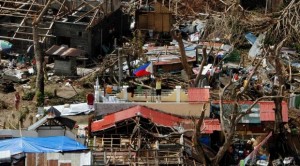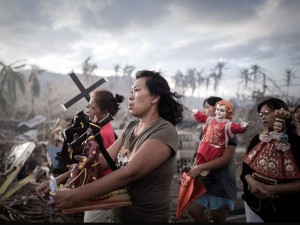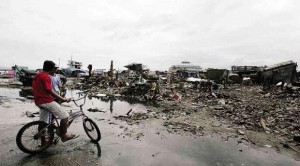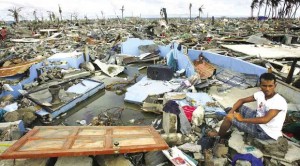Yolanda survivors: Each day a new day, for better or worse
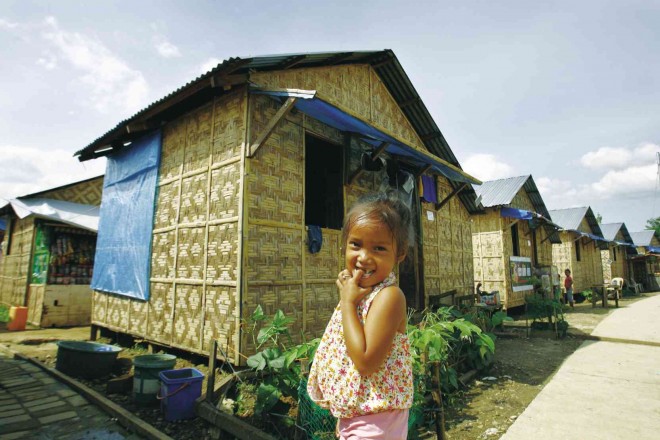
SMILE THAT MELTS THE HEART A young survivor Luzviminda Baldo, 5, who survived the fury of Supertyphoon “Yolanda,” poses at New Kawayan transitional housing site in Tacloban City. RAFFY LERMA
TACLOBAN—He is far from the grieving man captured in a news photograph seated in the rubble of his flattened home at Costa Brava amid a sea of debris left by Supertyphoon “Yolanda.”
Of the 23 people who sought refuge in Melvin Castro’s two-story home, only six survived the deadly winds and tsunami-like waves spawned on Nov. 8, 2013, by the most powerful storm to ever hit the country.
The memory of a failed effort to save his siblings, nephews and nieces hanging on for dear life on wooden planks and his mother telling him she preferred a swift rather than a slow death before she disappeared in the raging water still haunt Castro.
But today, the 29-year-old high school graduate flashes a smile as he wields a spade to mix cement in a relocation site of GMA TV’s Kapuso Village at Barangay Kawayan in the outskirts of Tacloban City.
“I’m moving on, this is a first step,” said Castro, one of the fortunate Yolanda survivors to get a unit in the housing project.
“I would have been happier if they are all here,” said the lean, sun-bronzed Castro, talking about the loved ones who perished in the storm.
Pain of loss remains
The pain of loss remains among the victims eight months after the November monster struck and killed more than 6,000 people.
It is etched on the face of Roland Maca, 25, a forlorn figure under the noonday sun at Barangay Cologcog standing on a triangular highway junction that had been turned into a makeshift graveyard.
Three candles were flickering in the wind on the marble slab marking the site where his sister Michelle, 24, a grandmother and her brother were buried. They were among 20 people who died while sheltering in his house as the storm raged.
“She was a good sister,” Maca said, softly recounting how she was hit in the head by a wooden missile while attempting to help an old woman climb the rafters of the two-story house as the seawater menacingly rose.
Any time soon, 50 cyclone-proof units in the rows of concrete “loftable” apartments will be raffled off to Castro’s family and other beneficiaries in the project for 400 families as part of the television network’s commitment to help the Aquino administration’s “build back better” program.
Help from top firms
Some of the nation’s top corporations, including Robinsons, SM, PLDT-Smart, Ayala, International Container Terminal Services, Jollibee-Mang Inasal and Lopez Group of Companies, have joined the administration initiative.
Most of the GMA TV beneficiaries are from Barangay 88, a largely squatter colony of fishermen, pedicab drivers and vendors crammed in half a dozen hamlets that include Costa Brava at the edge of the Leyte Gulf.
The chosen occupants are required to put in 500 hours of volunteer work in the project to give them a sense of ownership.
Castro’s brother Marlon, 26, was selected in a stroke of luck after months of living on a knife’s edge. Marlon listed Castro among eight dependents—the number of minimum occupants for a 22 square-meter unit.
All about jobs
On a roll, Marlon later found a job as poultry feed salesman. And so he called Castro, who had left for Manila in January to try his luck and rid his mind of the Yolanda tragedy, to fulfill the work requirement at the site.
Without jobs in the calamity zone, Castro had joined the exodus to Manila. But there he hit a dead end. He found employment for a month in a cash-strapped construction company that could barely meet its payroll. He decided to return home.
He is happy he will have a roof over his head and far from the sorry memories by the sea, but he shrugs when he is asked what the future has in store without jobs in sight at Kapuso Village in the middle of nowhere.
Lack of livelihood opportunities is the most serious concern at the village, as it is elsewhere in the country, where a quarter of the population is mired in poverty.
Where to get the next meal troubles Ailyn Alberca, 38, mother of seven children, the youngest baby in her arms at a “transitional site” on a hill at Barangay Pago, also in the outskirts of Tacloban, for Yolanda survivors in danger zones awaiting relocation.
Her husband is a crewman on a trawler that goes on fishing expeditions in the high seas for a week—taking home as much as P2,000 at times, zilch on days when the engine breaks down, or when the nets get torn.
“We need jobs,” said Alberca as other women, children with runny noses in tow, nodded in agreement.
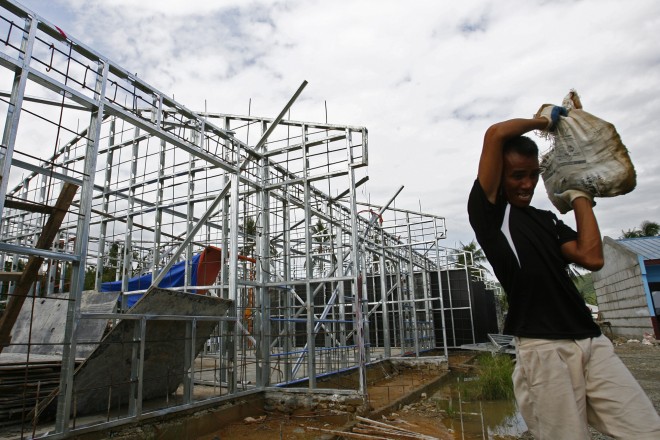
Melvin Castro volunteers in the construction of housing units at a relocation site og GMA Kapuso Foundation in partnership with NHA and Tacloban City Government at Barangay Sto. Nino, Tacloban City for victims of super typhoon Yolanda. Castro and his family will be one of the beneficiaries of the housing units after super typhoon Yolanda destroyed their house in Barangay 88, San Jose, Tacloban City. INQUIRER PHOTO/RAFFY LERMA
Tzu Chi a lifesaver
They recalled that when Typhoon “Glenda” tore across Luzon last week and brought torrential rain in Tacloban for days, the displaced went hungry. Food assistance is now few and far between since the humanitarian emergency ended several months ago.
Luckily there was the Buddhist Compassion Relief Tzu Chi Foundation, the world’s largest Chinese humanitarian agency based in Taiwan, which distributed 15 kilos of rice to each family at Barangay Pogo.
Tzu Chi was first to respond to the humanitarian crisis in Tacloban after Yolanda struck. It launched a cash-for-work program that energized residents out of their stupor.
On Thursday, thousands of people lined up for hours in several distribution points in Tacloban to receive Tzu Chi rice.
With the rainy season now in full swing, authorities in Tacloban are urgently rushing transitional sites to shelter the Yolanda survivors in no-dwelling zones.
Ironically, land has become hard to come by as life slowly crawls back to normal in Tacloban, where the supertyphoon destroyed or damaged 54,231 houses.
Leo Jopson, an urban housing consultant at City Hall, says land values had gone up from P100 to P300 per square meter in the municipality.
Around 5,000 families in unsafe areas in Tacloban have still to be relocated. They stay in tents given by the United Nations and other charities during the emergency, and now tattered and worn out, in huts cobbled from salvaged wood, plastic and iron sheets, and wooden bunkhouses.
“They are our immediate concern,” said Jopson.
Last month, a mother and her six children were killed in a fire that gutted their tent at Costa Brava.
Stopgap measure
At the height of Glenda’s battering, workers of UN agencies and the nongovernment organization Community and Family Services International helped local authorities evacuate thousands living along the coastal areas to the city astrodome and nearby schools.
Glenda was the strongest to hit the country since Yolanda and showed the vulnerability of the Yolanda survivors.
As a stopgap measure, the city government is identifying sites to build thatch huts that are semipermanent. “We need to provide them with basic utilities, health centers, water, power and schools,” said Jopson.
All told, 14,000 families in Tacloban are in need of permanent shelters at the cost of P3.4 billion.
In the entire disaster zone, the national government says more than 200,000 households in areas tagged as unsafe in 112 cities and municipalities require resettlement and a budget of close to P100 billion.
Showcase in rebuilding
Mayor Pel Tecson of Tanauan has taken the lead in the reconstruction effort, making his municipality—one of the heavily devastated areas in the calamity zone—a showcase in the rebuilding initiative.
Cyclone-resistant houses of concrete, built in a partnership between the privately run shelter charity Gawad Kalinga and the state National Housing Authority, are springing in several villages in the municipality.
Since early this year, 92 families have been moved to the completed sites.
Tecson, 46, a former regional deputy marketing chief of the multinational consumer company Procter & Gamble based in Singapore, has secured rice seeds for farmers, 20 hand tractors to plow the rice fields, and four tractors to clear felled coconut trees in order to plant alternative crops like cocoa, ginger and corn.
He has also gotten several 40-footer boats to allow fishermen to venture farther out into the sea.
The typhoon had devastated marine life in the coastal areas, which even before had been overfished, reducing the income of one of the poorest sectors of the Philippine economy.
“I’m happy where we are now, but things can be better,” said Tecson, who has enlisted one of the nation’s tycoons, Edgar “Injap” Sia, founder of the food chain Mang Inasal, to help in rebuilding badly damaged infrastructure.
He wears a cotton shirt on which is inscribed in the back, “Each new day is a better day in Tanauan.”
The biggest challenge
Providing livelihood is Tecson’s biggest challenge.
At the newly opened resettlement site at Barangay Pago in Tanauan, residents relocated from the devastated coastal village of San Roque talked about the lack of sustainable employment.
“We have a nice house. People think we are rich, but our stomachs are growling,” said Bienvenido de Paz, 63, an occasional laborer. “We need jobs now. Of what use is the grass if the horse is dead?”
De Paz is a college dropout and father of three, the eldest a daughter who used to be a crabmeat picker in a food shop before Yolanda shut it down.
In his younger days, he traveled the country as a Baptist catechist for cultural minorities, but later decided to stay in Tacloban. “What is really the meaning of life?” he asked himself. “What do we need in this world?”
In one unit in the apartment block where De Paz spoke to a group of men and women whiling away time outside under the shade of a tarpaulin, a 21-year-old woman who survived Yolanda but was stricken with tuberculosis died of pneumonia on Saturday. She was waiting for relatives from nearby towns to bury her.
RELATED STORIES
Aquino: ‘Time to help each other’
Glimpses of devastation a day after ‘Yolanda’
